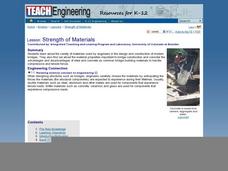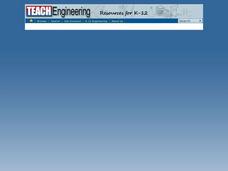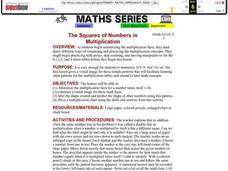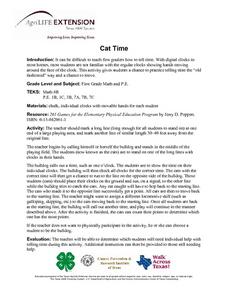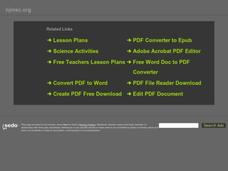Curated OER
Acid Attack
Learners explore the effect of chemical erosion on statues and monuments. They use chalk to see what happens when limestone is placed in liquids with different pH values. They also discover several things that engineers are doing to...
Curated OER
Eek, It leaks!
Middle schoolers construct model landfill liners out of two-inch strips of garbage bags within resource constraints. The challenge is to construct a bag that will hold one cup of water without leaking. This represents similar challenges...
Curated OER
From Lake to Tap
Middle schoolers use the Internet to study how water is treated to make it safe to drink. They use a tutorial on the U.S. Environmental Protection Agency's website to gain this information. They complete a worksheet for the assessment...
Curated OER
How Full is Full?
Young scholars examine porosity and permeability and relate these concepts to groundwater flow. They use simple materials to conduct a porosity experiment and use the information to understand how environmental engineers decide on the...
Curated OER
The Search for Secret Agents
Students embark on a scavenger hunt around the school looking for indoor air pollution and mapping source locations. They predict and observe sources of indoor air pollution, understand and give examples of technologies we use related to...
Curated OER
Moving without Wheels
Learners observe a simple water cycle model to better understand its role in pollutant transport. This activity shows one way in which pollution is affected by the water cycle; it simulates a point source of pollution in a lake and the...
Teach Engineering
Alloy Advantage
Mix it up by using an intriguing resource that teaches young metallurgists that alloys are a metal mixture. They learn about the advantages of using alloys over pure metals and investigate titanium alloys as an example to finish the...
Teach Engineering
Airplane Tails and Wings: Are You in Control?
Keep everything under control. The lesson, the 16th segment in a 22-part unit, provides a more detailed look at the parts of a plane, specifically the control surfaces. Pupils learn about the construction of the wings and the tails and...
Teach Engineering
Strength of Materials
Pupils examine a stress-strain diagram that compares the advantages and disadvantages of the two common bridge building materials, concrete and steel. The also consider the factors that influence the materials builders choose for their...
Teach Engineering
The Cloning of Cells
Did you know that there are over 200 different types of cells in the human body? One type, the stem cell, is the focus of the fifth of six installments in the Cells unit. The lesson plan asks the class to discuss stem cells and their...
Teach Engineering
Biot-Savart Law
Electrical current going round and round,produces a magnetic field. After a demonstration of the magnetic field surrounding an electrical wire, class members use the provided formula associated with Biot-Savart's Law to calculate the...
Teach Engineering
Archimedes' Principle, Pascal's Law and Bernoulli's Principle
What do Pascal's law, Archimedes' Principle, and Bernoulli's Principle have to do with fluid mechanics? The included PowerPoint presentation provides the basic definitions and equations associated with the three. A set of homework...
Teach Engineering
Viscous Fluids
Elasticity and viscosity. Help your class understand the similarities and differences with an introduction to viscous fluids. After describing four types of fluid behaviors: shear thinning, shear thickening, Bringham plastic, and...
Teach Engineering
How Antibiotics Work
Take two pills and call me in the morning. The first lesson in a short unit of four introduces class members to delivery methods of medicines. The instruction introduces the question of which delivery method is best to get you feeling...
Teach Engineering
The Temperature Effect
How temperature affects the efficiency of a solar panel is the focus of the third in a series of eight resources that presents how engineers are able to control the temperatures of photovoltaic panels. Class members find out how the...
Cornell University
Magnetic Mad Libs
Examine the science behind computer communication. After defining the properties of magnets, learners simulate how a computer hard drive works by sending each other binary codes using the magnets. They use these communications to...
Curated OER
Let Your Fingers Do the Estimating
Investigate estimation with the White Pages. Youngsters use the phonebook to estimate the average number of phone listings that can be found there. They write a paragraph explaining the processes they used in this challenge.
Curated OER
The Squares of Numbers in Multiplication
Review multiplication facts and concepts! This clear, and easy to follow lesson will help your class to understand multiplication by using arrays and repeated addition. There are strategies to help with memorization and manipulative...
Curated OER
Volume of a Rectangular Prism
Children use the length, width, and height of an object to calculate the volume of a rectangular prism. They observe how to multiply three numbers at a time, and define volume. Pupils observe as the teacher demonstrates how to determine...
Curated OER
Introduction to Biometrics
Students use the internet to research how biometrics is being used in the real world today. They work together to research hand geometry applications. They share their findings with the class.
Curated OER
Comparing Sizes And Shapes
Students compare, resize, and check various shapes by size using a comparison mat from the MathKeys program. Working in pairs, they place three similar shapes on the screen and state which is the largest and smallest in area. They also...
Curated OER
Cat Time
First graders demonstrate telling time on clocks. They stand at one end of a field while the teacher calls out a time. They )cats) who set their clocks to the correct time try to run past the teacher (bulldog) without getting caught.
Curated OER
Fashion Day
Eighth graders practice using basic measurements to solve word problems.They also investigate finding the perimeter of different polygons and define the characteristics to classify the shape as a polygon.
Curated OER
Water Quality Monitoring
Learners study the water quality of a stream in their area, by measuring the temperature, pH, alkalinity and conductivity. They integrate biology with earth science when using the microscope to study the living organisms in the water.










